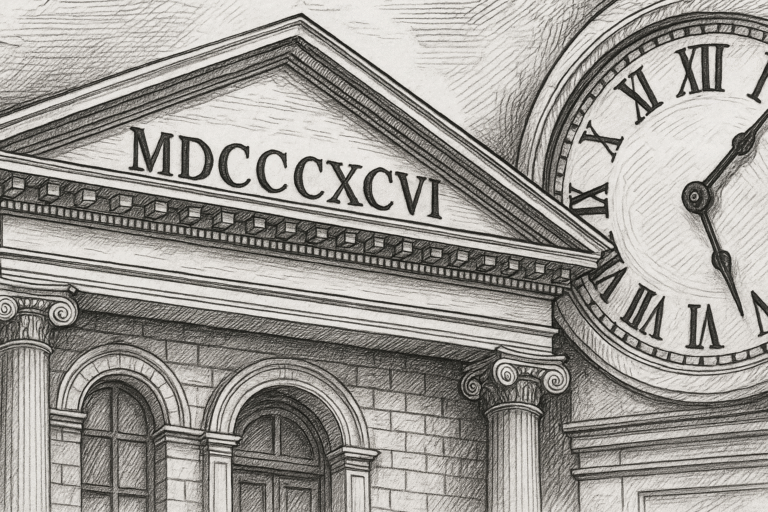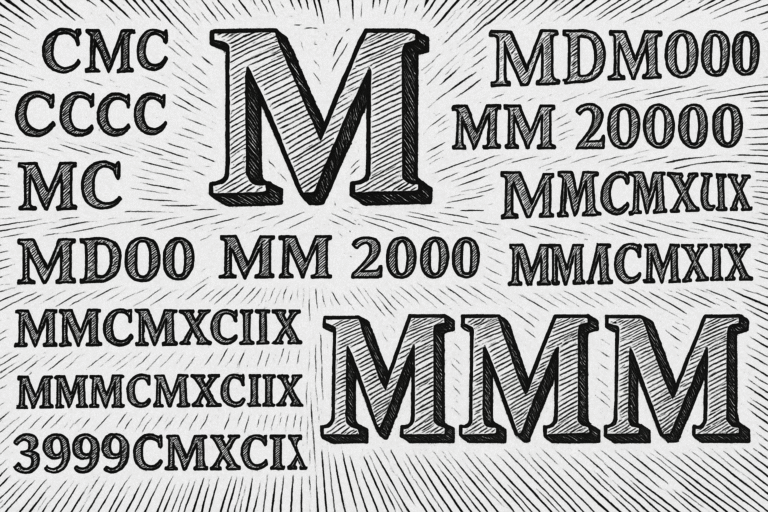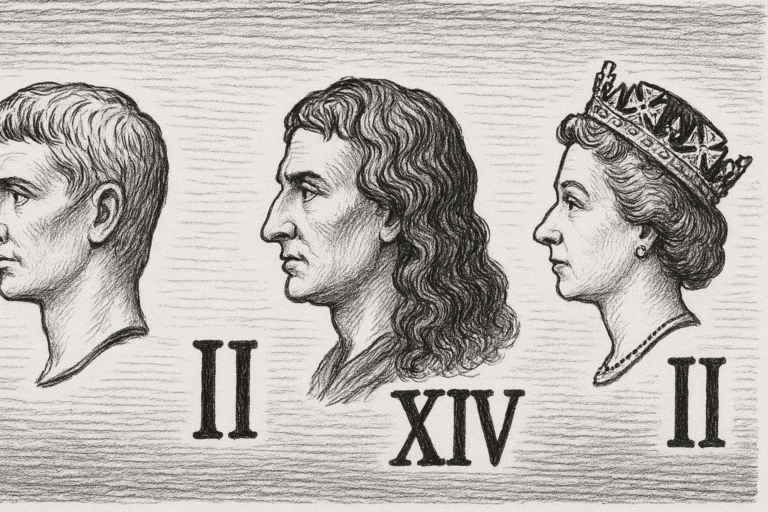How to Represent Large Numbers (4,000+) in Roman Numerals: A Comprehensive Guide

Roman numerals, originating in ancient Rome, are a fascinating numeric system still used today in contexts like book outlines, clock faces, and movie credits. While most people are familiar with representing smaller numbers using letters like I (1), V (5), X (10), and so on, handling large numbers—those 4,000 and above—introduces unique challenges and conventions.
Understanding Roman Numerals: A Quick Overview
Before diving into large numbers, let’s recap the basics of Roman numerals. The system uses seven letters, each with a specific value:
- I: 1
- V: 5
- X: 10
- L: 50
- C: 100
- D: 500
- M: 1000
Roman numerals are built using two primary principles:
- Addition: When letters of equal or greater value are placed in sequence, their values are added (e.g., VI = 5 + 1 = 6, XX = 10 + 10 = 20).
- Subtraction: When a smaller value precedes a larger one, the smaller value is subtracted (e.g., IV = 5 – 1 = 4, XC = 100 – 10 = 90).
For numbers up to 3,999, these rules suffice. However, representing numbers 4,000 and above requires additional methods, as the standard system becomes cumbersome. Let’s explore how the Romans and modern users handle large numbers.
The Challenge of Large Numbers in Roman Numerals
In standard Roman numeral notation, the largest single letter is M (1,000). To represent 3,999, you’d write MMMCMXCIX (3,000 + 900 + 90 + 9). But what about 4,000 or higher? Writing thousands of Ms (e.g., MMMM for 4,000) is inefficient and prone to errors. To address this, the Romans developed a system called the vinculum (or overbar), and modern adaptations sometimes use alternative notations. Below, we’ll break down these methods and their applications.
Traditional Method: The Vinculum (Overbar)
The primary method for representing large numbers in ancient Rome was the vinculum, a horizontal bar placed above a Roman numeral to multiply its value by 1,000. This allowed the Romans to express numbers in the thousands, tens of thousands, and beyond concisely.
How the Vinculum Works
- A numeral with a vinculum is multiplied by 1,000.
- For example:
- V̅ = 5 × 1,000 = 5,000
- X̅ = 10 × 1,000 = 10,000
- C̅ = 100 × 1,000 = 100,000
- Subtractive rules still apply under the vinculum. For instance:
- I̅V̅ = (5 – 1) × 1,000 = 4,000
- X̅C̅ = (100 – 10) × 1,000 = 90,000
Examples of Large Numbers with Vinculum
- 4,000:
- Written as I̅V̅ = (5 – 1) × 1,000 = 4,000.
- 5,500:
- Break it down: 5,000 + 500.
- 5,000 = V̅, 500 = D.
- Combine: V̅D = 5,000 + 500 = 5,500.
- 49,999:
- Break it down: 40,000 + 9,000 + 900 + 90 + 9.
- 40,000 = X̅L̅ (50 – 10) × 1,000.
- 9,000 = I̅X̅ (10 – 1) × 1,000.
- 900 = CM, 90 = XC, 9 = IX.
- Combine: X̅L̅I̅X̅CMXCIX = 40,000 + 9,000 + 900 + 90 + 9 = 49,999.
Limitations of the Vinculum
While effective, the vinculum has drawbacks:
- Typographical Challenges: In modern digital formats, rendering the overbar can be difficult. Unicode supports vinculum notation (e.g., V̅ as U+0305), but it’s not universally supported in all fonts or systems.
- Complexity: Large numbers with multiple vinculums can become hard to read (e.g., X̅C̅C̅M̅ for 100,000,000).
- Historical Rarity: The vinculum was not always consistently used, and some ancient inscriptions relied on repeating M or other methods.
Alternative Historical Methods
In some historical contexts, the Romans used other techniques to represent large numbers, though these were less common:
1. Apostrophus Notation
In early Roman inscriptions, an apostrophus (a symbol resembling a parenthesis or hook) was used to indicate multiplication by 1,000. For example:
- C) = 100 × 1,000 = 100,000.
- This method was less standardized and fell out of use, replaced by the vinculum.
2. Repetition of M
For numbers just above 4,000, some inscriptions simply repeated M. For example:
- 4,000 = MMMM.
- This approach was practical for smaller thousands but became unwieldy for very large numbers like 50,000 (MMMMM…).
3. Multiplicative Frames
In rare cases, Romans used symbols like |C| to indicate 100 × 1,000 = 100,000. This was similar to the vinculum but used enclosing symbols instead of an overbar. This method is largely obsolete today.
Modern Adaptations for Large Numbers
In modern contexts, Roman numerals for numbers above 3,999 are less common due to the efficiency of Arabic numerals. However, when they are used (e.g., in formal documents, academic settings, or decorative designs), alternative notations have emerged to handle large numbers without relying on the vinculum, which is challenging in digital formats.
1. Parenthetical Notation
Some modern systems enclose Roman numerals in parentheses to indicate multiplication by 1,000:
- (IV) = 4 × 1,000 = 4,000.
- (V)D = (5 × 1,000) + 500 = 5,500.
This method is not historically accurate but is sometimes used in textbooks or informal settings for clarity.
2. Avoiding Large Numbers
In many modern applications, numbers above 3,999 are simply written as Arabic numerals. For example:
- In movie credits, you might see “Volume IV” for 4, but “Year 2025” instead of MMXXV.
- This avoids the complexity of vinculums or excessive M repetition.
3. Extended Vinculum for Millions
For very large numbers (e.g., millions), some modern adaptations use a double vinculum to indicate multiplication by 1,000,000:
- V� weird symbol ̅ = 5 × 1,000,000 = 5,000,000.
- This is rare and mostly academic, as Arabic numerals are preferred for such scales.
Practical Examples of Large Numbers in Roman Numerals
Let’s apply these methods to represent large numbers, focusing on the vinculum as the most historically accurate approach.
Example 1: 4,500
- Break it down: 4,000 + 500.
- 4,000 = I̅V̅ (5 – 1) × 1,000.
- 500 = D.
- Combine: I̅V̅D = 4,000 + 500 = 4,500.
Example 2: 10,999
- Break it down: 10,000 + 900 + 90 + 9.
- 10,000 = X̅.
- 900 = CM, 90 = XC, 9 = IX.
- Combine: X̅CMXCIX = 10,000 + 900 + 90 + 9 = 10,999.
Example 3: 100,000
- 100,000 = C̅ (100 × 1,000).
- No additional numerals needed.
Example 4: 1,000,000
- 1,000,000 = M̅ (1,000 × 1,000).
- Alternatively, in rare modern notation: M� weird symbol ̅ (1,000 × 1,000,000).
Common Mistakes and How to Avoid Them
When working with large Roman numerals, errors can occur. Here are common pitfalls and tips to avoid them:
- Overusing M: Writing MMMMM for 5,000 is technically correct but non-standard and cumbersome. Use V̅ instead.
- Incorrect Subtraction: Avoid invalid subtractive forms like IM for 999 (use CMXCIX).
- Misinterpreting Vinculum: Ensure the vinculum applies to the correct numerals. For example, I̅V is incorrect; it should be I̅V̅ for 4,000.
- Digital Rendering Issues: If the vinculum isn’t supported, consider parenthetical notation or Arabic numerals for clarity.
Applications of Large Roman Numerals
Large Roman numerals are rarely used today but appear in specific contexts:
- Historical Studies: Scholars analyzing Roman inscriptions need to understand vinculum notation.
- Formal Documents: Some academic or legal documents use Roman numerals for large section numbers.
- Decorative Design: Large Roman numerals may appear in architecture or art for aesthetic purposes.
- Education: Learning large Roman numerals helps students grasp the system’s flexibility.
Tips for Working with Large Roman Numerals
- Master the Vinculum: Memorize that a vinculum multiplies by 1,000 and applies to both additive and subtractive forms.
- Break Down Numbers: Divide large numbers into thousands, hundreds, tens, and units for easier conversion.
- Use Conversion Tools: Online Roman numeral converters can handle large numbers, though they may not support vinculums.
- Practice with Examples: Convert numbers like 5,000, 10,000, or 50,000 to build confidence.
- Know When to Switch: For practical purposes, consider using Arabic numerals for numbers above 3,999 in modern contexts.
Conclusion
Representing large numbers (4,000 and above) in Roman numerals requires understanding traditional methods like the vinculum and recognizing modern adaptations. The vinculum, multiplying a numeral’s value by 1,000, is the most historically accurate approach, allowing concise representation of numbers like 4,000 (I̅V̅) or 100,000 (C̅). While alternative methods like parenthetical notation or repeating M exist, they are less standard. By mastering these conventions and practicing with examples, you can confidently handle large Roman numerals in historical, educational, or decorative contexts. For further exploration, try converting large numbers yourself or consult online tools to verify your work. Roman numerals may be ancient, but their elegance and utility endure!





